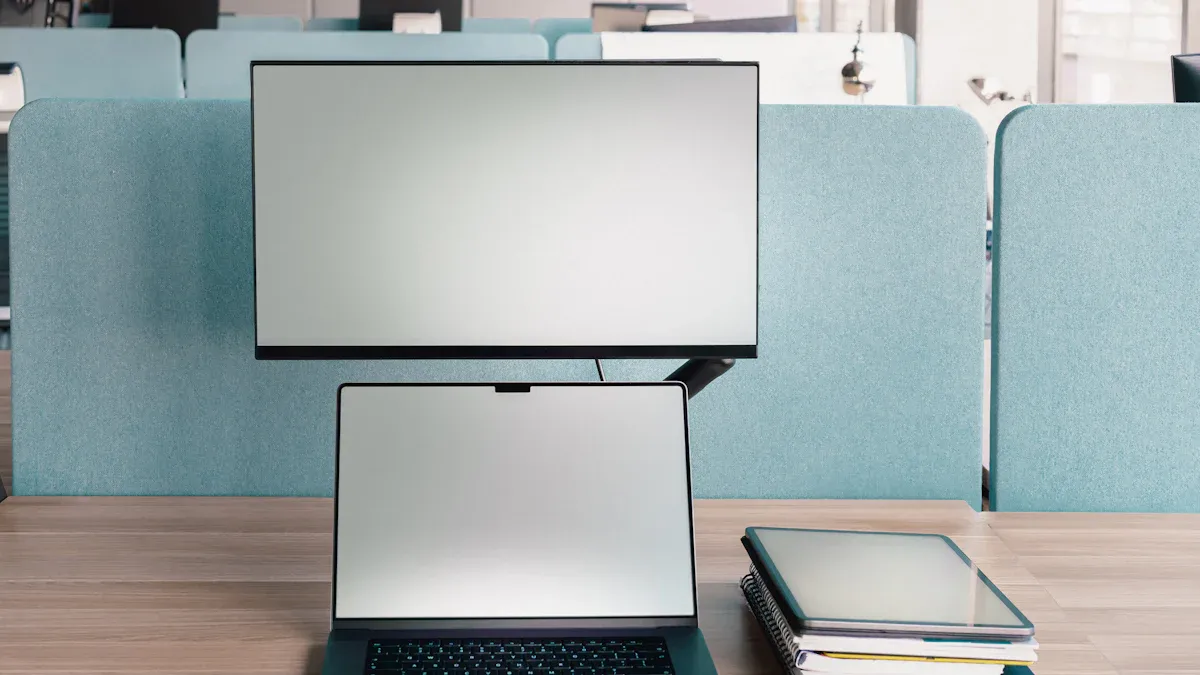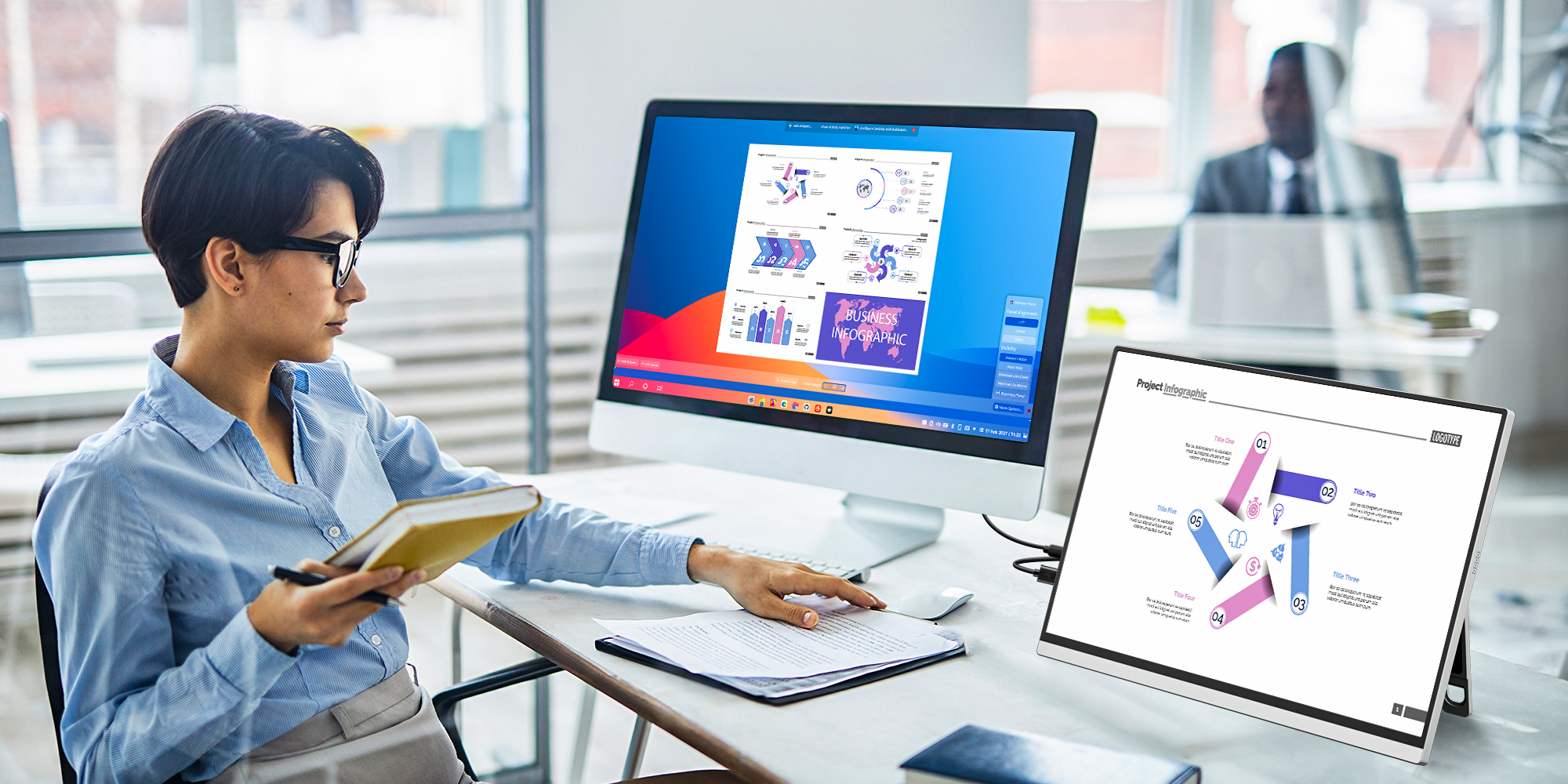The Best Portable Displays for Laptops Tested and Reviewed

Do you ever feel stuck with just one laptop screen? A portable monitor for laptop lets you add another screen anywhere you go. In 2025, these monitors are more popular than ever. Why is that? Remote work and online learning have made them super useful for getting more done.
Here’s a cool fact: the portable monitor market grows over 10% each year. About 70% of remote workers say they work better with an extra screen. Whether you’re working, gaming, or studying, a Portable monitor for laptop can make things easier and help you do more.
Key Takeaways
Portable monitors help you work, play games, or study better.
Think about size and weight; lighter ones are easier to carry, but bigger screens are clearer to see.
Choose high resolution and good display quality; IPS screens show colors better and are great for creative work.
Check how it connects; USB-C ports make setup simple with fewer cables.
Look at power options; monitors with batteries are handy for travel and won’t use up your laptop’s power.
Factors to Think About When Picking a Portable Monitor
Size and Portability
When choosing a portable monitor, size and portability matter a lot. You need one that works for you and is easy to carry. Bigger screens are easier to see but can be heavy and take up space. Smaller screens are lighter and easier to pack but may feel cramped.
Tip: If you travel often, pick a light and small monitor. If you stay in one place, a bigger screen might be better. The best monitor is easy to carry and still gives a good view.
Resolution and Display Quality
Good resolution and display quality are very important. Higher resolution makes pictures and text look sharper. This is helpful for tasks like editing videos or designing graphics. Many monitors in 2025 have resolutions from 1080p to 4K.
Monitors with IPS screens are great. They show colors better and let you see clearly from different angles. This is useful for creative work or sharing your screen. Keep in mind, 2.5K monitors cost more, but the sharpness and colors are worth it.
Refresh Rate and Response Time
For gaming or video editing, refresh rate and response time are key. A higher refresh rate, like 144Hz, makes motion smoother. Response time shows how fast pixels change color. Lower response times mean less blur and clearer images.
For everyday use, 60Hz is fine. But gamers and creative users should get monitors with higher refresh rates and faster response times. For example, the VEOUT V1 PRO has a 144Hz refresh rate, making games and videos look amazing.
Connectivity Options
When choosing a portable monitor, how it connects is important. You need one that links to your laptop or devices easily. Today’s portable monitors are much better at this. Many now have USB-C ports, which are very handy. With one cable, you can send power and video. This keeps your setup neat and simple.
Some monitors also have wireless options like Bluetooth or Wi-Fi. These are great if you dislike cables. Imagine connecting your monitor to your laptop or phone without plugging in anything. It’s super helpful for traveling. HDMI ports are still common too. They work well with gaming consoles or older laptops.
Tip: If you travel often, pick a monitor with USB-C or wireless features. It will save time and make things easier.
Power Requirements
Power is another thing to think about. Some portable monitors have built-in batteries, while others use your laptop’s power. Monitors with batteries are heavier but don’t drain your laptop. Battery-free ones are lighter but may use up your laptop’s battery faster.
Here’s a simple guide to power terms:
Budget and Value for Money
Portable monitors come at different prices. Some cost less than $150, while others go over $500. The trick is to match your needs with your budget. If you only need a second screen for simple tasks, a cheaper monitor works fine. But for gaming or creative work, spending more on a high-quality monitor with features like 2.5K resolution and a 144Hz refresh rate is worth it.
Note: The VEOUT V1 PRO is a good example of great value. It has a 2.5K resolution, 144Hz refresh rate, and excellent colors, making it ideal for gamers and professionals.
Compatibility with Laptops and Other Devices
Choosing a portable monitor that works with your devices is important. Many monitors today use USB-C for easy connection. This single cable sends video and power together. It helps keep your desk tidy and avoids extra wires.
Some older laptops don’t have USB-C ports. They might need HDMI or other connectors instead. Always check your laptop’s ports before buying a monitor. Newer laptops, like MacBooks or Windows models, often have USB-C ports. These are great for portable monitors.
Here’s how portable monitors work with different devices:
Device Type | Compatibility Result |
|---|---|
MacBooks | Worked perfectly |
iPhones | Worked perfectly |
Windows laptops | Worked perfectly |
Valve Steam Deck | Worked perfectly |
Asus Zenbook S 16 | Not compatible |
Older Lenovo | Worked perfectly |
Intel Core Ultra | Worked perfectly |
MacBooks (M1 to M4) | Worked perfectly |
iPhone 15 Pro | Worked perfectly |
Gamers can use portable monitors with consoles like Nintendo Switch, Xbox, or PlayStation. Playing games on a bigger screen while traveling is awesome!
Tip: Check your device’s details before buying a portable monitor. This helps avoid problems with compatibility.
How We Tested

Testing Criteria
We used a clear process to test each monitor fairly. All monitors were bought from stores to avoid any bias. Before testing, we let the monitors warm up to prevent startup issues. Every monitor went through the same steps to ensure fair comparisons.
We checked important features like brightness, contrast, and color accuracy. Tools like Calman Ultimate software and the Calibrite ColorChecker Display Plus helped us measure these. We also compared monitors side by side to confirm the results. This way, you can trust how well each monitor works.
Criteria/Methodology | Description |
|---|---|
Purchase Method | Monitors bought from stores to avoid bias. |
Testing Process | Same steps used for all monitors for fairness. |
Warm-Up Procedure | Monitors warmed up first for steady results. |
Visual Comparison | Side-by-side tests for accurate visual checks. |
Real-World Use Cases
We tried these monitors in everyday settings to see how they work. For example, we used them in cafés for tasks like writing and watching videos. This showed how they handle daily activities.
Portable monitors were also tested in work settings. One factory used touch screen monitors to check production lines remotely. This made work faster and reduced delays. In shared offices, these monitors helped teams share screens easily for better teamwork.
Tip: If you travel or work in shared spaces, a portable monitor can help you multitask better.
Performance Benchmarks
We tested performance using standard benchmarks. Most monitors had 15.6-inch screens and 1080p resolution, but some had 2.5K for sharper images. For gaming, monitors with 144Hz refresh rates and quick response times were the best. We also tested brightness for outdoor use, and screens over 300 nits worked well.
Benchmark Aspect | Description |
|---|---|
Screen Size | 16 inches common; 2.5K options for clearer visuals. |
Refresh Rate | 60Hz is normal; 144Hz or more is great for gaming. |
Brightness | Screens over 300 nits are good for outdoor use. |
Color Accuracy | Important for artists; tested for good colors right out of the box. |
Build Quality and Durability
Portable monitors need to be strong to last long. A sturdy monitor can handle bumps or drops without breaking. Many good monitors use tough materials like reinforced plastic or aluminum alloy. These materials look nice and resist scratches or small impacts. Aluminum alloy frames are light but strong, making them great for travel.
Some brands test their monitors in hard conditions. They check if screens work well in sunlight, humidity, or temperature changes. This ensures the monitor works anywhere, like a sunny café or humid office. Llimink, for example, uses strong parts and tests carefully. Their monitors stay reliable if you take care of them.
Tip: Travel often? Pick a monitor with a strong frame. It will protect against damage.
User Experience and Ease of Use
A portable monitor should make things easier, not harder. That’s why it’s important to have a simple setup. Monitors with USB-C ports are very popular. They use one cable for power and video, keeping your desk tidy.
Studies show 70% of remote workers do better with an extra screen. High-resolution monitors help because they show clear pictures. This reduces eye strain and makes tasks like reading or editing easier. Battery life is also important. Over 60% of people like monitors that last more than 5 hours. This way, they don’t need to find outlets while traveling.
Note: Look for easy setup and long battery life. These features make daily use much better.
Portable monitors are super handy in 2025, giving you more options. Whether you play games, work, or study, there’s one for you. The VEOUT V1 PRO is a great pick. It has 2.5K resolution, a 144Hz refresh rate, and bright colors. This makes it awesome for gaming and creative tasks.
Think about what you need before buying a portable monitor. Do you travel a lot? A light monitor with USB-C might be perfect. Want better performance? Choose one with features like 2.5K resolution or IPS screens.
Pro Tip: A portable monitor can help you get more done. It’s great for gaming, working, or just having fun. A small change can make a big difference!
FAQ
What is a portable monitor, and why use one?
A portable monitor is a lightweight extra screen. You can connect it to your laptop or other devices. It’s great for multitasking, gaming, or working anywhere. It helps you get more done and makes tasks like editing or gaming more fun.
How do portable monitors connect to laptops?
Most portable monitors use USB-C or HDMI ports to connect. Some also have wireless options like Bluetooth or Wi-Fi. If your laptop has USB-C, one cable powers and connects the monitor. This is super handy for travel or keeping your desk neat.
Tip: Check your laptop’s ports to make sure it works with the monitor.
Can portable monitors work with gaming consoles?
Yes! Portable monitors like the VEOUT V1 PRO work well with consoles. These include Nintendo Switch, Xbox, and PlayStation. You’ll get a bigger screen, smoother gameplay, and bright colors. It’s perfect for gaming on the go or in small spaces.
Do portable monitors need their own power?
Some monitors have built-in batteries, while others use your laptop’s power. Monitors with batteries last longer but are heavier. If you travel a lot, pick one with a battery that lasts over 5 hours. This way, you won’t need to find a power outlet often.
Are portable monitors compatible with MacBooks?
Yes! Many portable monitors, like VEOUT models, work perfectly with MacBooks. They support features like IPS technology and 16:10 aspect ratios. This gives you amazing visuals. Just plug it in, and it’s ready to use.
Note: VEOUT monitors are popular with Mac users for their sleek look and great performance.
